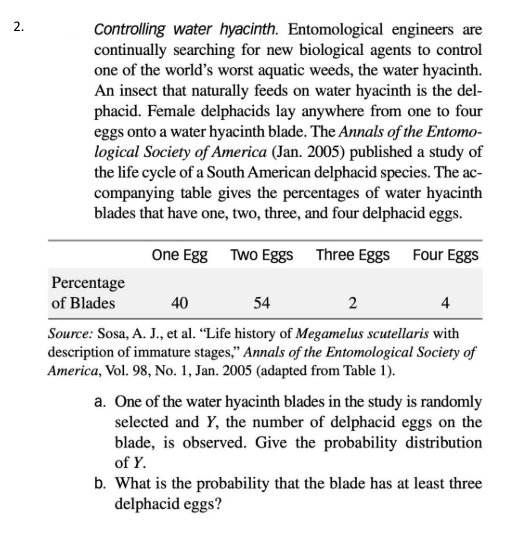Controlling water hyacinth. Entomological engineers are continually searching for new biological agents to control one of the world's worst aquatic weeds, the water hyacinth. An insect that naturally feeds on water hyacinth is the del- phacid. Female delphacids lay anywhere from one to four eggs onto a water hyacinth blade. The Annals of the Entomo- logical Society of America (Jan. 2005) published a study of the life cycle of a South American delphacid species. The ac- companying table gives the percentages of water hyacinth blades that have one, two, three, and four delphacid eggs. One Egg Two Eggs Three Eggs Four Eggs Percentage of Blades 40 54 2 4 Source: Sosa, A. J., et al. "Life history of Megamelus scutellaris with lescription of immature stages," Annals of the Entomological Society of \merica, Vol. 98, No. 1, Jan. 2005 (adapted from Table 1). a. One of the water hyacinth blades in the study is randomly selected and Y, the number of delphacid eggs on the blade, is observed. Give the probability distribution of Y. b. What is the probability that the blade has at least three delphacid eggs?
Controlling water hyacinth. Entomological engineers are continually searching for new biological agents to control one of the world's worst aquatic weeds, the water hyacinth. An insect that naturally feeds on water hyacinth is the del- phacid. Female delphacids lay anywhere from one to four eggs onto a water hyacinth blade. The Annals of the Entomo- logical Society of America (Jan. 2005) published a study of the life cycle of a South American delphacid species. The ac- companying table gives the percentages of water hyacinth blades that have one, two, three, and four delphacid eggs. One Egg Two Eggs Three Eggs Four Eggs Percentage of Blades 40 54 2 4 Source: Sosa, A. J., et al. "Life history of Megamelus scutellaris with lescription of immature stages," Annals of the Entomological Society of \merica, Vol. 98, No. 1, Jan. 2005 (adapted from Table 1). a. One of the water hyacinth blades in the study is randomly selected and Y, the number of delphacid eggs on the blade, is observed. Give the probability distribution of Y. b. What is the probability that the blade has at least three delphacid eggs?
Chapter8: Sequences, Series,and Probability
Section8.7: Probability
Problem 1E
Related questions
Question
Please answer a-b. Thanks!

Transcribed Image Text:Controlling water hyacinth. Entomological engineers are
continually searching for new biological agents to control
one of the world's worst aquatic weeds, the water hyacinth.
An insect that naturally feeds on water hyacinth is the del-
phacid. Female delphacids lay anywhere from one to four
eggs onto a water hyacinth blade. The Annals of the Entomo-
logical Society of America (Jan. 2005) published a study of
the life cycle of a South American delphacid species. The ac-
companying table gives the percentages of water hyacinth
blades that have one, two, three, and four delphacid eggs.
One Egg Two Eggs Three Eggs Four Eggs
Percentage
of Blades
40
54
2
4
Source: Sosa, A. J., et al. “Life history of Megamelus scutellaris with
description of immature stages," Annals of the Entomological Society of
America, Vol. 98, No. 1, Jan. 2005 (adapted from Table 1).
a. One of the water hyacinth blades in the study is randomly
selected and Y, the number of delphacid eggs on the
blade, is observed. Give the probability distribution
of Y.
b. What is the probability that the blade has at least three
delphacid eggs?
2.
Expert Solution
This question has been solved!
Explore an expertly crafted, step-by-step solution for a thorough understanding of key concepts.
This is a popular solution!
Trending now
This is a popular solution!
Step by step
Solved in 2 steps

Recommended textbooks for you

